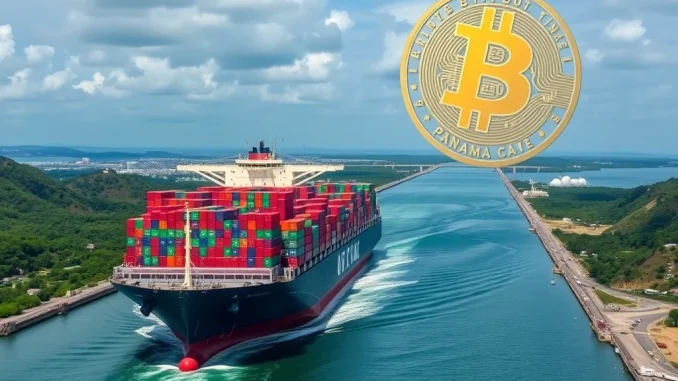
Imagine ships paying their passage through one of the world’s most vital waterways using Bitcoin. This isn’t just a futuristic concept; it’s a real exploration underway in Panama. The recent announcement from Panama City’s Mayor has sent ripples through the cryptocurrency world, signaling a potential intersection of global trade and digital finance. The move by Panama City to explore Bitcoin for public payments, including the iconic Panama Canal, is a significant step that could redefine how major international services handle transactions.
Panama City Explores Bitcoin for Public Services
At the recent Bitcoin 2025 conference, Panama City Mayor Mayer Mizrachi shared an intriguing vision for the city’s financial future. A key part of this vision involves integrating cryptocurrency into the city’s payment infrastructure. This isn’t entirely new territory for the city. Under Mayor Mizrachi’s leadership, a bill has already been passed allowing residents and businesses to pay taxes and fees using digital assets, specifically mentioning Bitcoin, Ether, and select stablecoins. This existing framework provides a foundation for expanding crypto use within the city’s operations.
The inspiration for these moves comes, in part, from El Salvador’s pioneering adoption of Bitcoin. While El Salvador made Bitcoin legal tender nationally, Panama City appears to be taking a more targeted approach, focusing on specific public payments and services first. This strategic implementation could allow the city to test the waters and build necessary infrastructure before potentially expanding further.
Could Bitcoin Panama Canal Transit Fees Become Reality?
Perhaps the most attention-grabbing proposal from Mayor Mizrachi is the idea of accepting Bitcoin for Panama Canal transit fees. The Panama Canal is a critical artery for global shipping, handling a vast volume of international trade. Introducing Bitcoin as a payment option for such a high-volume, high-value service presents both exciting opportunities and considerable challenges.
Mayor Mizrachi even floated the possibility of offering incentives for ships paying in Bitcoin, such as expedited passage. This could be a powerful motivator for shipping companies, potentially saving them valuable time and operational costs. For the city, accepting Bitcoin could streamline payment processes, reduce reliance on traditional banking intermediaries for international transactions, and potentially attract businesses and individuals already operating within the crypto economy.
Exploring the Potential of Bitcoin Payments
The prospect of large-scale Bitcoin payments for something like Canal transit fees brings several potential benefits into focus:
- Efficiency: Bitcoin transactions can settle faster than traditional international bank transfers, potentially speeding up the process for ships.
- Reduced Fees: Depending on the transaction size and network conditions, Bitcoin transaction fees might be lower than traditional wire transfer fees or currency exchange costs for large payments.
- Transparency: Transactions are recorded on a public ledger, offering a level of transparency.
- Accessibility: Provides an alternative payment rail, bypassing potential issues with traditional banking access or restrictions in certain regions.
- Innovation: Positions Panama City as a forward-thinking hub embracing financial technology.
However, implementing Bitcoin payments for a global service like the Canal also comes with significant hurdles:
- Volatility: The price of Bitcoin can fluctuate significantly, creating exchange rate risk for both the payer and the recipient unless transactions are immediately converted or managed carefully.
- Infrastructure: Requires robust technical infrastructure, reliable internet access, and secure wallet management systems.
- Regulation: Navigating international regulations and compliance requirements for accepting cryptocurrency payments from global entities.
- Adoption & Education: Shipping companies and their financial departments need to be willing and able to use Bitcoin, requiring education and technical support.
- Transaction Volume & Speed: While Bitcoin can be fast, handling potentially hundreds or thousands of large transactions daily requires careful system design.
Crypto in Panama: Beyond Canal Fees
The focus on the Panama Canal is significant due to its global profile, but the city’s crypto initiatives extend beyond this. The existing bill allowing residents to pay taxes and fees in Bitcoin, Ether, and stablecoins demonstrates a broader commitment to integrating digital currencies into daily civic life. This provides a testing ground and helps build public familiarity with using crypto for practical purposes.
The comparison to El Salvador is relevant, highlighting a regional trend towards exploring crypto adoption at the governmental level. While El Salvador’s approach is national and includes making Bitcoin legal tender, Panama City’s strategy appears more focused on specific use cases and municipal services, which might offer a different path to integration.
Mayor Mizrachi’s Vision: A Strategic Bitcoin Reserve?
Adding another layer to his vision, Mayor Mizrachi also proposed establishing a strategic Bitcoin reserve for Panama City. A municipal Bitcoin reserve could serve several potential purposes. It could be seen as a long-term investment, a hedge against inflation of traditional currencies, or a way to signal the city’s commitment to the digital asset space. Managing such a reserve would involve developing clear policies around acquisition, storage, and potential use, requiring financial expertise in managing volatile assets.
Conclusion: A Bold Step Towards Digital Integration
Panama City’s exploration of using Bitcoin for Panama Canal transit fees and other public payments is a bold and noteworthy development. While challenges related to volatility, infrastructure, and regulation remain, the potential benefits in terms of efficiency, cost savings, and attracting digital innovation are clear. Inspired by early adopters like El Salvador, Mayor Mizrachi’s vision positions Panama City at the forefront of cities exploring how cryptocurrency can be integrated into traditional governmental and economic structures. Whether ships will soon be queuing up to pay in satoshis remains to be seen, but the conversation alone marks a significant moment in the ongoing evolution of global finance and cryptocurrency adoption.



